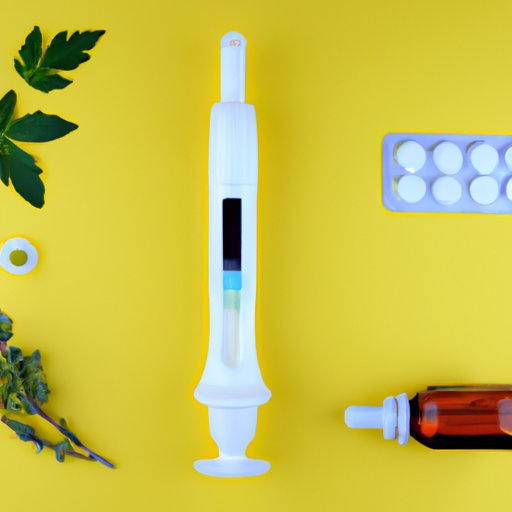
Introduction
Menstrual cramps are a painful reality for many women. They can disrupt everyday activities and make it difficult to focus on anything else. If you are tired of dealing with period cramps, there are various methods you can use to alleviate them and get back to your regular routine. This article will explore the causes of menstrual cramps and discuss different remedies and techniques to stop them.
Causes of Menstrual Cramps
There are various reasons why women experience cramps during their menstrual cycles. One of the most common causes is an imbalance of hormones. When your body produces too much prostaglandin, it leads to painful contractions of the uterus. Stress is another factor that can exacerbate menstrual cramps. Eating an unhealthy diet can make things worse.
Diet
What you eat can have a significant impact on your menstrual cramps. Certain foods can trigger inflammation and make things worse. Some of the foods you should avoid include caffeine, alcohol, processed foods, and saturated fats. Eating foods that are high in calcium, magnesium, and vitamin D can help to reduce menstrual cramps. Incorporating healthy dietary changes can provide long-term relief.
Exercise and Stretching
Regular exercise can help to alleviate menstrual cramps. Exercise releases endorphins, which act as natural painkillers. Some of the best exercises to reduce menstrual cramps include brisk walking, jogging, and cycling. Stretching can also help to ease cramps. Practicing yoga can help to relax your muscles and alleviate menstrual pain.
Guide to Stretches for Menstrual Cramps
Here are a few stretches you can try to ease your menstrual cramps:
- Child’s pose
- Seated forward bend
- Butterfly stretch
- Cobra pose
- Pigeon pose
Heat Therapy
Heat therapy is a simple and effective way to relieve menstrual cramps. Applying heat can help to relax the muscles and reduce inflammation. There are many different ways to apply heat therapy to your lower abdomen. Using a hot water bottle, taking warm baths, or applying warm towels to your lower stomach can all provide relief.
Precautions to Take While Using Heat Therapy
It is important to be cautious while using heat therapy. Avoid using high temperatures and make sure you do not burn yourself. Also, do not use heat therapy for extended periods. If you experience any adverse reactions, such as dizziness or nausea, remove the heat source immediately.
OTC Pain Relief Medication
Over-the-counter pain relief medication is another option to consider for menstrual cramps. Nonsteroidal anti-inflammatory drugs (NSAIDs) such as ibuprofen can help to reduce menstrual pain. Before taking any medication, make sure you read the instructions properly and take the correct dosage. It is also essential to keep possible side effects in mind and take the necessary precautions.
Potential Side Effects of Using NSAIDs and Precautions to Take
When taking NSAIDs, you may experience side effects such as stomach upset or dizziness. Make sure you take the medication with food to reduce the risk of stomach irritation. It is also best to avoid taking NSAIDs if you have a history of ulcers or bleeding disorders.
Use of Essential Oils
Essential oils have been known to help alleviate menstrual cramps. They have natural anti-inflammatory properties and can work effectively as a natural method of pain relief. Some of the essential oils you can consider using include lavender, peppermint, and chamomile oil.
Safe Methods to Apply Essential Oils for Menstrual Cramps
Essential oils can be applied topically or diffused into the air. When using essential oils topically, it is important to dilute them with a carrier oil like olive oil or coconut oil. Also, be sure to do a patch test before applying essential oils directly to your skin to avoid any potential allergic reactions.
Dietary Changes
Making dietary changes can be a long-term solution to menstrual cramps. Avoiding certain foods can help to reduce inflammation and alleviate cramps. On the other hand, incorporating healthy foods into your diet can boost your magnesium, calcium, and vitamin D intake, which can help to reduce menstrual pain.
Recommended Foods to Eat for Menstrual Cramps
Some of the foods you can eat to alleviate menstrual cramps include bananas, salmon, kale, and spinach. Drinking plenty of water also helps to stay hydrated, and dehydration can make menstrual cramps worse.
Conclusion
Menstrual cramps are a common problem experienced by many women. However, there are many different methods to alleviate the pain, ranging from diet changes to OTC pain relief medication. It is essential to find what works best for you and your body. Incorporating these remedies and techniques can help to reduce the intensity and frequency of menstrual cramps, allowing you to get back to your regular routine.
Final Tips and Advice for Dealing with Menstrual Cramps
- Stay active by exercising regularly.
- Avoid or limit caffeine and alcohol.
- Use a heating pad or hot water bottle.
- Stay hydrated by drinking plenty of water.




